ISSN ONLINE(2278-8875) PRINT (2320-3765)
ISSN ONLINE(2278-8875) PRINT (2320-3765)
Roshni Bhoi1, Dr. S.M. Ali2
|
| Related article at Pubmed, Scholar Google |
Visit for more related articles at International Journal of Advanced Research in Electrical, Electronics and Instrumentation Engineering
Power is a vital infrastructure input for the growth and development of any country. With change in environment, power generation method should be taken care. There various sources of energy renewable and non renewable. Though renewable source are easy source i.e. they are readily available everywhere, don’t depends on the climatic condition, but major drawback is it can be replenished. So, country are now focused toward the renewable source like wind, water, solar etc. hydropower here play a important role as renewable and convectional resource. Hydro power is further divide into; large hydro, medium hydro, small hydro and micro hydro. From all the design small hydro are now in main concern. The small hydro power are easy to construct and built on run off river. Since the speed of water is variable, the speed of the system need to controlled to make the system supply frequency constant. This can ne done by a properly designed hydraulic governing system.
Keywords |
| PID Governing system, PID servosystem, Turbine system, Small hydro power |
INTRODUCTION |
| Hydro power are now playing a vital energy resource for the fulfillment of power required for the growth and development of the country. It a pollution free, renewable and environmental friendly source of energy. Hydropower represents use of water resources towards inflation free energy due to absence of fuel cost with mature technology characterized by highest prime moving efficiency and spectacular operational flexibility. |
| Constructing hydroelectric dam across a the water flow is the most common method of using energy from a water, where this water flows to turbine and cause its rotation and the energy is captured to drive a generator. There a different type of hydro power plant i.e. large hydro(>100MW),medium hydro(50-100MW) ,small hydro(10-50MW) and micro hydro plant(<10MW). Small hydro are preferable over the other because it is generally build on the run off river where construction of dam is not required. The plant can be connected to conventional electrical distribution networks as it a low cost renewable source of energy. Beside this these can be built on the isolated area or the area which distributed electrification are not reachable. |
II. SMALL HYDRO POWER SYSTEM |
| The plant have the capacity from 10 to 50 MW and are built on the normal flowing river. This minimizes the civil works for construction a large dam or reservoir. Since the flow of river is variable, as water enter the turbine system varies. So to maintain the constant frequency of the power supply unit of a small hydro plant the speed needs to be control. Since the head is upto 2-100 meters, Kaplan turbine are preferred. The grid system f or small hydro is local which can feed 1-10,000 consumer capacity. The vertical turbine configuration keep the tail race value highest in the turbine house floor, thereby keeping the lower part of the turbine house water tight. In reaction turbine, Kaplan turbine, the speed is highest which also lower the cost of runner and alternator. To control the speed of a Kaplan turbine Proportionality-Integration-Derivative controller is used in the governing system. The basic block to control a speed of a hydraulic system are : governing system, servosystem, Hydraulic system and turbine dynamics. |
 \ \ |
III.PID GOVERNING SYSTEM |
| The main function a governing system is to control the network frequency on a isolates electrical network. This constant frequency can be brought into account if the speed is constant. The governor in a hydraulic system changes the rate of flow of water bringing the speed to a constant value. This main a balance between the input and output of the system. Since the flow of water in small hydro increase or decrease depending on the river condition, the chance of disturbance is more. So to make the error minimal Proportionality-Integration-Derivative controller is used in the governor control. This dynamic of PID controller is: the D mode reacts fast to the change in input to the controller, I mode leads the error to zero value by increasing the control signal and P mode takes suitable action to control the error. This modes help to determine the change in water speed from its rated value thereby a implementing a control mechanism to make the speed constant and eliminating the oscillation. Stability of the system is improved by the Derivative mode which enables in increase value of gain K and also decease integral time constant, thereby controller response speed increases. |
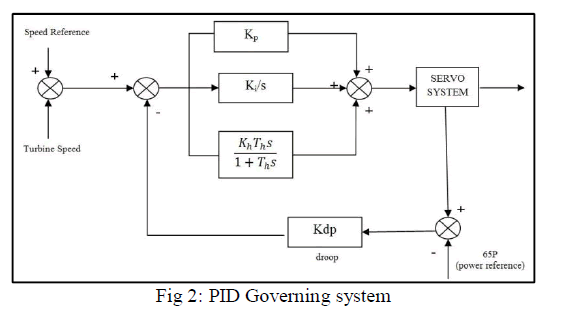 |
IV.PID SERVOSYTEM AS AMPIFIER MODE |
| A servosystem consist of a controller, amplifier, motor and a position sensor. The servosystem receives signal from governing system. These signal are amplified and electric current is transmitted to the servo motor to produce motion which is proportional to input signal. The position sensor report the actual status of the motor. This position is compared with the input value. Any deviation in the system is identified by Proportionality-Integration-Derivative controller and give fast response to the change. |
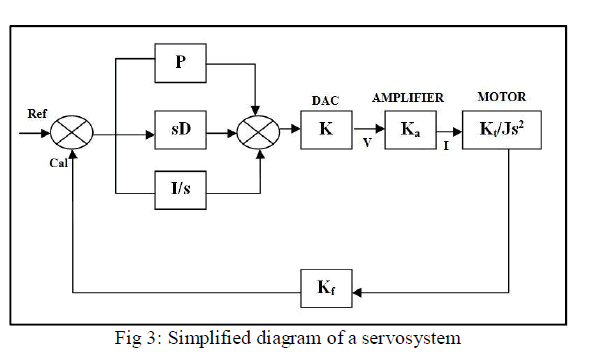 |
V.HYDRAULIC SYSTEM |
| A hydraulic system main constituent are turbine generator set. The turbine system is characterized by speed characteristic. Its main function is the production of electrical energy from the kinetic energy of water flow. The discharge of water depends on the gate position, head and turbine speed. When water flow to a turbine, the force of discharge water result in mechanical energy production. The torque developed by the force define the speed of the hydraulic turbine. The speed need to be control even though there is an increase and decease in load. The constant value of system supply frequency depend on the speed control. Thus, controlled speed avoid over-speed or underspeed thereby minimizes oscillation. |
VI.MATHMATICAL MODELLING |
| 1. Servosystem |
| In PID controller, the transfer function F(s), related to x number of output to e position error, is, |
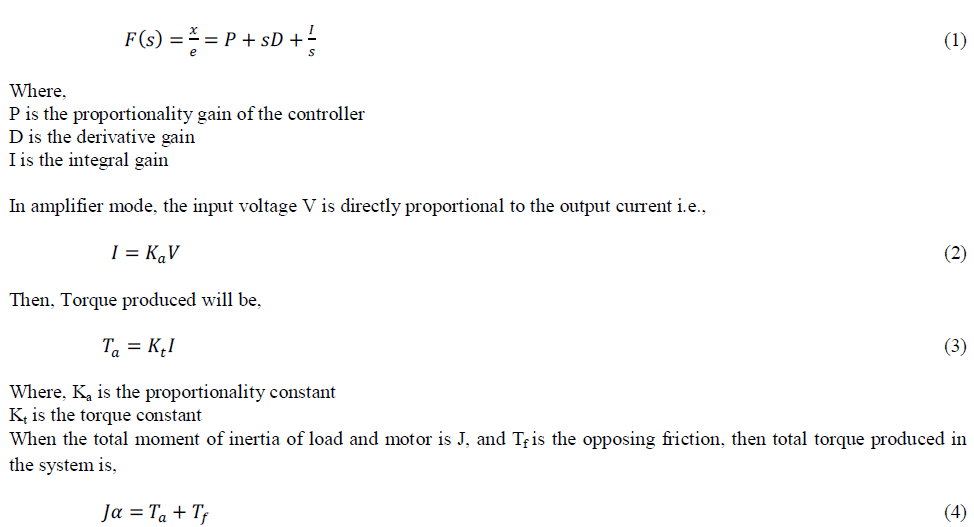 |
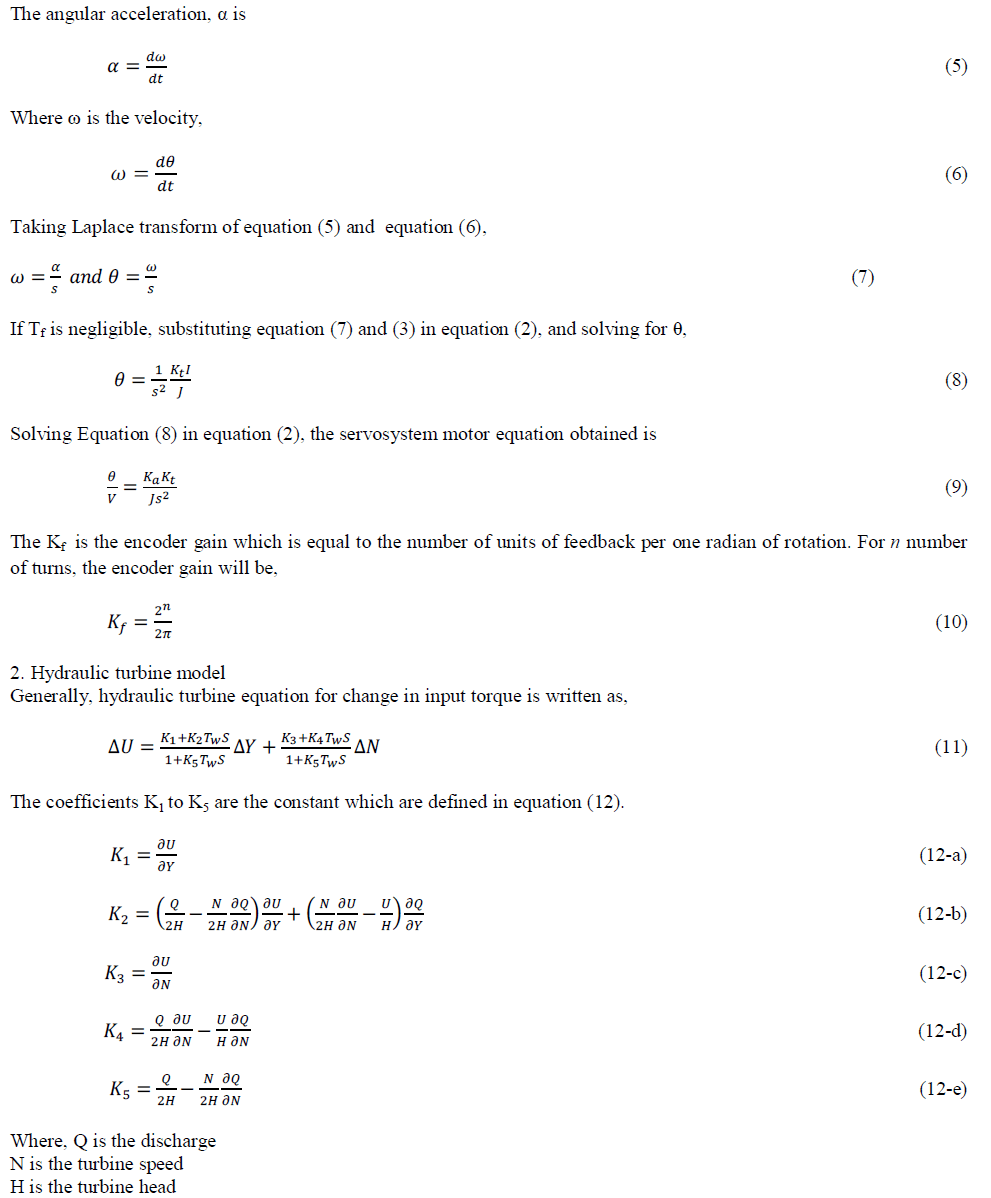 |
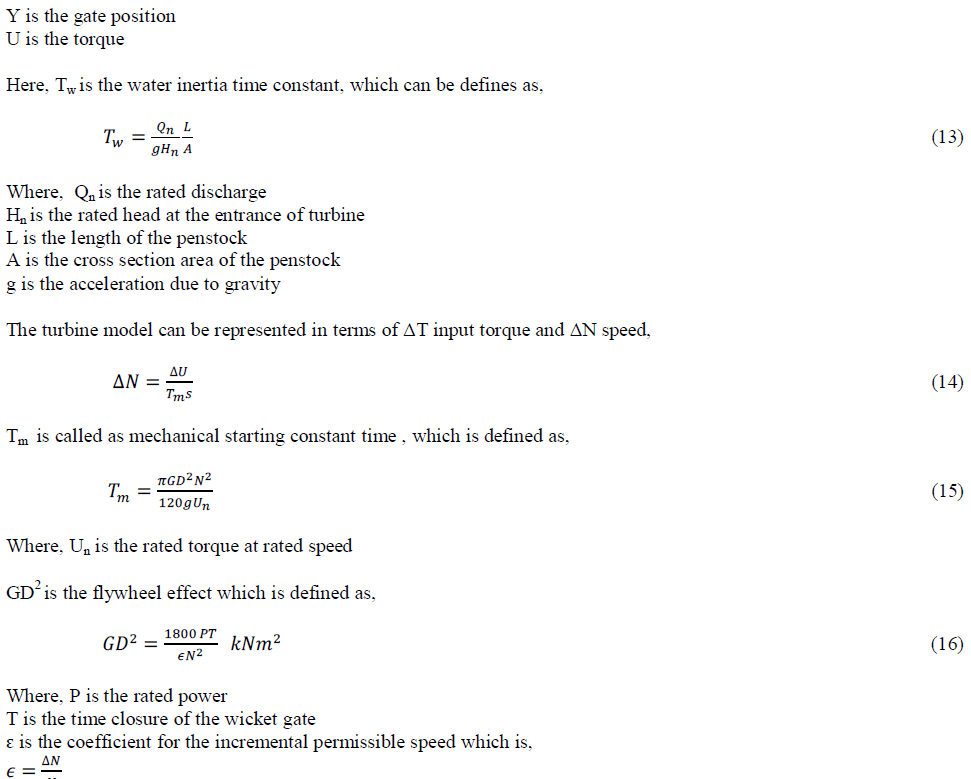 |
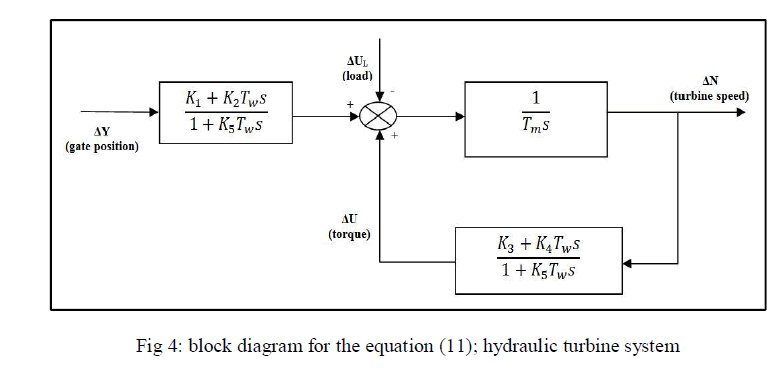 |
VII.INPUT DATAS |
| The data taking for the simulation, |
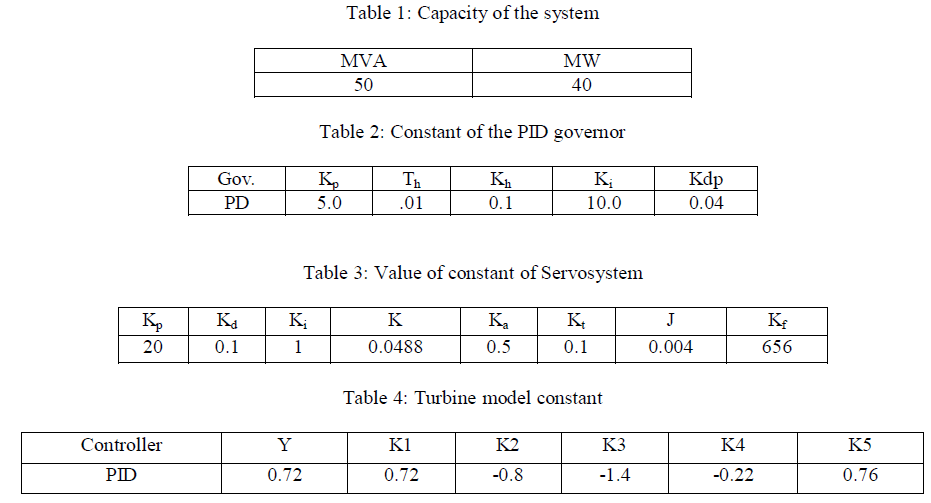 |
IX.SIMULATION AND RESULT |
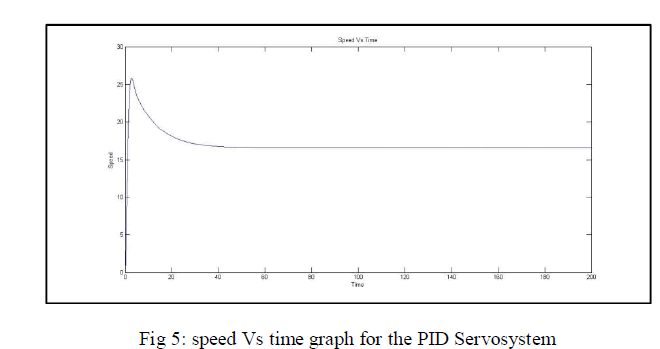 |
| In the Fig 5, there is a sudden rise in speed when the system input is feed to the servosystem. The PID controller gives a fast reaction to the sudden rise in speed thereby responding to the change. The controller brings back the speed to a constant value and the amplifier amplifies the signal avoiding the oscillation in the speed characteristic. |
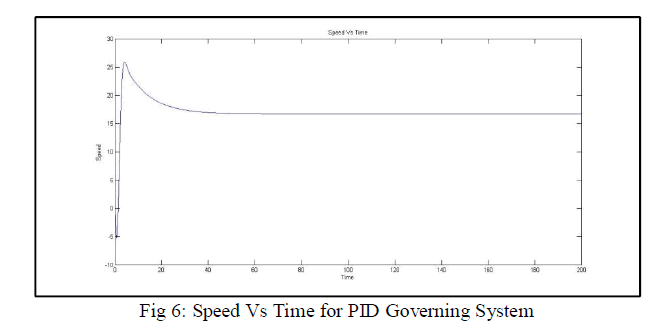 |
| In fig 6, the speed is brought back to a constant value after a sudden rise in value. This rising value is due to sudden force of water to the hydraulic turbine. Presence of permanent droop compensator determines the amount of output change in response to a change in unit speed and try to compensate it. |
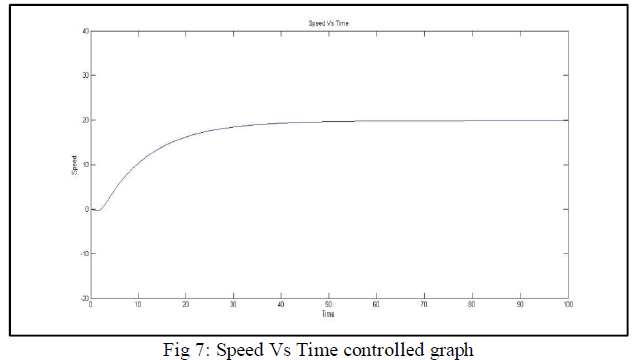 |
| From the graph Fig 7, it can be analysis that the settling time for the speed is less. The speed becomes constant within 30sec. the over speed and losses are minimizes due to the low settling time. Thus, system frequency is maintained by controlled speed. In place of the PID controller if it would have been replaced by a PD controller the settling time would have been greater which depicts the essence of usage of PID controller as it in short increases the efficiency of the plant. |
X.CONCLUSION |
| In local grid supplied SHP are being implemented now a day because of its various advantages over other form of energy. It don’t disturbs the local habitat, requires less civil construction, which indirectly result in minimum maintenance cost. The small hydro plants across a river also control flooding. But speed in a hydraulic power plant is a important factor which need to be control in anyway. Control speed avoid over heat of the system, minimizes losses and also keep the supply frequency constant. |
References |
|